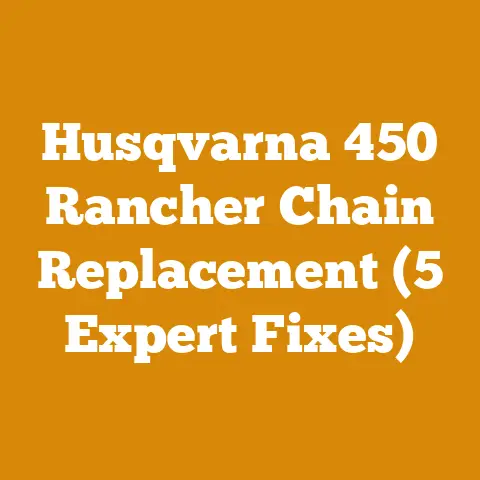GMC C6500 Wood Hauling Tips (5 Pro Arborist Insights)
GMC C6500 Wood Hauling Tips: 5 Pro Arborist Insights to Save You a Fortune
Alright, let’s talk about hauling wood with a GMC C6500. I’ve spent years in the field, from the dense forests of the Pacific Northwest to the sprawling timberlands of the Southeast, wrestling with everything from towering pines to stubborn hardwoods. And believe me, I’ve learned a thing or two about making the most of a medium-duty workhorse like the C6500. This article isn’t just about loading logs; it’s about maximizing efficiency, minimizing costs, and keeping your operation profitable. I’ll share five pro arborist insights, packed with real-world experience and data, that can significantly impact your wood hauling budget.
Understanding the Stakes: Why Efficient Wood Hauling Matters
First, let’s get real. Hauling wood isn’t just about getting it from point A to point B. It’s a significant cost center. Fuel, labor, maintenance, and potential downtime all eat into your profits. Optimizing your wood hauling operation with a GMC C6500, or any similar vehicle, is crucial for several reasons:
- Reduced Fuel Consumption: Efficient loading and route planning directly impact fuel costs, which are a major expense.
- Minimized Labor Costs: Streamlined processes mean less time spent loading, unloading, and securing loads.
- Lower Maintenance Expenses: Overloading and improper loading techniques can damage your truck, leading to costly repairs.
- Increased Productivity: More efficient hauling means more loads per day, boosting your overall output.
- Enhanced Safety: Proper loading and securing techniques prevent accidents and injuries, protecting your crew and equipment.
Insight #1: Mastering the Art of Weight Distribution & Load Capacity
This is where things get technical, but it’s absolutely crucial. Exceeding your GMC C6500’s Gross Vehicle Weight Rating (GVWR) is a recipe for disaster. Not only is it illegal and unsafe, but it also puts undue stress on your truck’s engine, transmission, brakes, and suspension.
- Understanding GVWR: The GVWR is the maximum permissible weight of your truck, including the chassis, body, passengers, fuel, and cargo. This information is typically found on a sticker inside the driver’s side doorjamb.
- Calculating Payload Capacity: Payload capacity is the maximum weight of cargo you can legally carry. It’s calculated by subtracting the truck’s curb weight (weight without cargo) from the GVWR.
-
Wood Weight Considerations: This is where it gets tricky. The weight of wood varies significantly based on species and moisture content.
- Species: Hardwoods like oak and maple are denser and heavier than softwoods like pine and cedar.
- Moisture Content: Green wood (freshly cut) can weigh significantly more than seasoned (dried) wood.
Here’s a table illustrating the approximate weight per cord (4ft x 4ft x 8ft stack) of different wood species at varying moisture contents:
Wood Species Green Weight (lbs/cord) Air-Dried Weight (lbs/cord) Oak 5,500 – 6,000 3,800 – 4,200 Maple 5,000 – 5,500 3,500 – 3,900 Ash 4,800 – 5,200 3,300 – 3,700 Birch 4,500 – 5,000 3,100 – 3,500 Pine 3,000 – 3,500 2,000 – 2,500 Cedar 2,500 – 3,000 1,700 – 2,200 Source: Various forestry extension services and wood density databases.
Personal Story: I remember one time, early in my career, I drastically underestimated the weight of a load of green oak. I was so eager to get the job done that I overloaded the truck. The consequences were immediate: sluggish acceleration, poor braking, and a very uncomfortable ride. I learned a valuable lesson that day: always err on the side of caution when estimating wood weight.
-
Weight Distribution is Key: Even if you’re within the GVWR, improper weight distribution can cause handling problems and damage your truck. Aim for a balanced load, with the heaviest items positioned over or slightly ahead of the rear axle. Avoid concentrating weight at the very front or rear of the bed.
- Utilizing Scales: The best way to ensure you’re within the legal weight limits is to use a truck scale. Many truck stops and weigh stations offer this service for a small fee. This is a worthwhile investment that can save you from fines and potential accidents. In the US, fines for overweight vehicles can range from a few hundred dollars to several thousand, depending on the severity of the violation and the state.
Pro Tip: Invest in a handheld moisture meter. This inexpensive tool allows you to quickly and accurately assess the moisture content of the wood, giving you a better estimate of its weight.
Insight #2: Mastering Loading Techniques for Efficiency and Safety
Loading wood efficiently and safely is an art form. It’s not just about piling logs into the bed of your truck. It’s about minimizing wasted space, securing the load properly, and preventing damage to your equipment.
- Layering and Stacking: Stack logs tightly together, minimizing gaps and air pockets. Use a layered approach, placing larger logs at the bottom and smaller logs on top. This helps to distribute the weight evenly and prevent shifting during transport.
- Utilizing Load Binders and Straps: Load binders and straps are essential for securing your load. Use high-quality straps with a sufficient weight rating. Ensure that the straps are properly tightened and that they are not frayed or damaged. A good rule of thumb is to use at least four straps for a standard load.
- Chain vs. Strap: There is always a debate on whether to use chains or straps. Chains are more durable and resistant to abrasion, making them suitable for rougher loads and environments. Straps are lighter and easier to handle, offering more flexibility in securing irregular loads. The choice depends on the specific needs of your operation. I have found that a combination of both is ideal: chains for the base layer and straps for securing the upper layers.
- Preventing Load Shifting: Load shifting is a major safety hazard. To prevent it, use timbers or wedges to secure the logs in place. Consider using a headache rack to protect the cab of your truck from shifting logs.
- Safety First: Always wear appropriate personal protective equipment (PPE) when loading and unloading wood, including gloves, safety glasses, and steel-toed boots. Be aware of your surroundings and avoid standing in the path of moving logs.
Personal Story: I once saw a load of logs shift on a steep mountain road. The driver was lucky to maintain control of the truck, but the incident could have been catastrophic. The lesson learned was that even the most experienced drivers can be caught off guard if the load isn’t properly secured.
Cost Savings: Improving loading techniques can directly impact your bottom line. By minimizing wasted space, you can haul more wood per load, reducing the number of trips required. This translates to lower fuel and labor costs.
Insight #3: Strategic Route Planning: Fuel Efficiency and Time Savings
The most powerful truck and the best loading techniques are useless if you’re driving inefficiently. Strategic route planning is essential for minimizing fuel consumption and maximizing time savings.
- Utilizing GPS and Mapping Software: GPS and mapping software can help you identify the most efficient routes, avoiding traffic congestion, steep inclines, and other obstacles that can increase fuel consumption.
- Considering Road Conditions: Be aware of road conditions, especially during inclement weather. Avoid driving on unpaved roads or roads with poor traction, as this can increase fuel consumption and the risk of accidents.
- Optimizing Driving Habits: Aggressive driving habits, such as rapid acceleration and hard braking, can significantly increase fuel consumption. Drive smoothly and maintain a steady speed.
- Avoiding Peak Traffic Hours: Driving during peak traffic hours can significantly increase travel time and fuel consumption. Try to schedule your trips to avoid these periods.
- Maintenance Schedules: Regular maintenance of your GMC C6500 is crucial for optimal fuel efficiency. Keep your tires properly inflated, change your oil regularly, and address any mechanical issues promptly.
Data Point: Studies have shown that optimizing driving habits can improve fuel efficiency by as much as 15%. This can translate to significant cost savings over the course of a year.
Cost Savings: Effective route planning can save you hundreds, if not thousands, of dollars per year in fuel costs. It also reduces wear and tear on your truck, extending its lifespan and minimizing maintenance expenses.
Insight #4: Leveraging Technology for Enhanced Efficiency
Technology has revolutionized the logging and wood hauling industries. There are a variety of tools and technologies available that can help you streamline your operations, reduce costs, and improve safety.
- Telematics Systems: Telematics systems provide real-time data on your truck’s location, speed, fuel consumption, and other performance metrics. This information can be used to identify areas for improvement and optimize your driving habits.
- Electronic Logging Devices (ELDs): ELDs are required by law in many jurisdictions. They automatically record driving time and other data, ensuring compliance with hours-of-service regulations.
- Load Tracking Software: Load tracking software allows you to track the location of your loads in real-time, improving communication and coordination with your customers.
- Mobile Apps: There are a variety of mobile apps available that can help you with route planning, load calculations, and other tasks.
Case Study: I know a logger who implemented a telematics system in his fleet of trucks. He was able to reduce fuel consumption by 10% and improve driver safety by 15%. The investment in the telematics system paid for itself within a few months.
Insight #5: Negotiation and Strategic Partnerships: Procurement and Sales
The final piece of the puzzle is understanding how to negotiate effectively and build strategic partnerships. Whether you’re buying timber or selling firewood, your ability to negotiate can significantly impact your profitability.
- Timber Procurement: When buying timber, research current market prices and negotiate with landowners to get the best possible deal. Consider purchasing timber in bulk to take advantage of volume discounts.
- Fuelwood Sales: When selling firewood, understand your costs and price your product competitively. Consider offering different grades of firewood at different price points.
- Building Relationships: Building strong relationships with landowners, suppliers, and customers is essential for long-term success. Treat people fairly and honestly, and they will be more likely to do business with you in the future.
- Exploring Strategic Partnerships: Consider partnering with other businesses in the wood processing industry. This can help you share resources, reduce costs, and expand your market reach. For example, you could partner with a sawmill to purchase logs at a lower price, or you could partner with a landscaping company to sell your firewood.
Data Point: A study by the Forest Products Association found that companies with strong supplier relationships are 20% more profitable than those with weak relationships.
Personal Story: I once negotiated a long-term timber supply agreement with a local landowner. By guaranteeing him a steady stream of income, I was able to secure a favorable price for the timber. This agreement proved to be a win-win for both of us.
Cost Savings: Effective negotiation and strategic partnerships can significantly reduce your costs and increase your profits. By building strong relationships and exploring new opportunities, you can create a more sustainable and profitable business.
Actionable Takeaways & Next Steps
So, there you have it – five pro arborist insights to help you optimize your wood hauling operation with a GMC C6500. Here’s a quick recap and some actionable steps you can take today:
- Master Weight Distribution: Calculate your GVWR and payload capacity. Invest in a moisture meter and use truck scales to ensure you’re within legal limits.
- Optimize Loading Techniques: Stack logs tightly and use high-quality straps and binders. Prioritize safety at all times.
- Plan Strategic Routes: Utilize GPS and mapping software to identify the most efficient routes. Consider road conditions and avoid peak traffic hours.
- Leverage Technology: Explore telematics systems, ELDs, and load tracking software to improve efficiency and safety.
- Negotiate and Build Partnerships: Research market prices and negotiate with landowners, suppliers, and customers to get the best possible deals.
Next Steps:
- Review Your Current Operations: Identify areas where you can improve efficiency and reduce costs.
- Invest in the Right Equipment: Purchase the tools and technology you need to optimize your operations.
- Train Your Crew: Ensure that your crew is properly trained in safe and efficient wood hauling techniques.
- Monitor Your Progress: Track your key performance indicators (KPIs) to measure your progress and identify areas for further improvement.
Final Thoughts
Hauling wood is a challenging but rewarding profession. By implementing these pro arborist insights, you can significantly improve your efficiency, reduce your costs, and increase your profitability. Remember, it’s not just about getting the job done; it’s about getting it done safely, efficiently, and sustainably. So, get out there, haul some wood, and make a difference!






